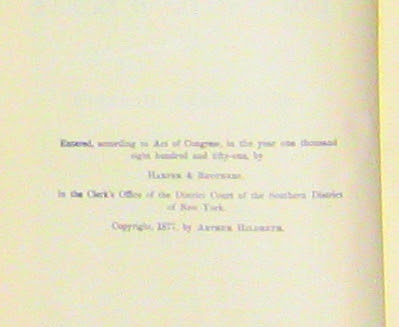 The great entrance screen put into the White House in 1882-3 by Louis Comfort Tiffany. Here you see office seekers posing for the camera.
The great entrance screen put into the White House in 1882-3 by Louis Comfort Tiffany. Here you see office seekers posing for the camera. Here is the entrance with out the office seekers
Here is the entrance with out the office seekers This is a good view of that amazing piece of work by Tiffany, which sadly does not exist today.
This is a good view of that amazing piece of work by Tiffany, which sadly does not exist today. Every room bore the unmistakable stamp of Tiffany.
Every room bore the unmistakable stamp of Tiffany. Chester A. Arthur 1829-1886. He was known as elegant Arthur for his extravagant tastes and lavish parties. He was James A. Garfield's Vice President and on the death of Garfield, Arthur took over not only the office but the total redesigning of the White House.
Chester A. Arthur 1829-1886. He was known as elegant Arthur for his extravagant tastes and lavish parties. He was James A. Garfield's Vice President and on the death of Garfield, Arthur took over not only the office but the total redesigning of the White House. Louis Comfort Tiffany 1848-1933...Tiffany was responsible for a totally new style of leaded colored glass that revolutionized the entire world of fashion and decoration.
Louis Comfort Tiffany 1848-1933...Tiffany was responsible for a totally new style of leaded colored glass that revolutionized the entire world of fashion and decoration. The East Room, which at this time looked more like the main hall of a Hudson River Steamer.
The East Room, which at this time looked more like the main hall of a Hudson River Steamer. The dinning room
The dinning room The other side of the screen
The other side of the screen The library
The library A little piece of pattern for the main entrance. You can see the intricate design and colors that were a part of that amazing piece of Victorian art.
A little piece of pattern for the main entrance. You can see the intricate design and colors that were a part of that amazing piece of Victorian art.In 1882 the very dapper Chester A. Arthur, President of the United States got sick of all the old stuff he saw sitting around the White House. Now to him that stuff was junk, not the priceless artifacts of unmentionable value that we today know them to be.
But it was 1882 and to the eyes of the Victorian is was passe'
...30 wagon loads of history were carted out of the White House and put on a public auction. In that batch were chairs from the administration of James Monroe. Andrew Jackson's standing desk, Lincoln's desk, clocks, tables, chairs, all went the way of the auctioneers block..
Then the very modern Arthur hired Louis Comfort Tiffany to totally redesign the interior of the White House. No room was safe from his styling. There were just a few that were not changed.
The great piece was the multi colored glass screen in the entrance to the White House. It was Tiffany's masterpiece. It was made of red, white, and blue glass in a gathering of other colors in a background. The patterns included American eagles, and a shield with stripes, stars, and the initials U.S. It was massive in every way you can imagine.
The White House would remain in this Tiffany style for but only 20 years. In 1902 another President, Theodore Roosevelt, who was not into fancy stuff and frills had the architects McKim, Mead, and White bring the house back to a more colonial style. The first thing to go was the screen.
The great glass panel by Tiffany that cost $15,000 to make was purchased for $275 by a real estate developer, and it ended its days at the Belvedere Hotel in Chesapeake Beach, Maryland, which burned down in 1923. That was the end of that great piece of art.
But for 20 years the White House was Tiffany palace. After 1902 most of it went into the trash.










































